Exploring the intersection of spaceflight history, pop culture, and space art.
This month’s post contains a time sensitive announcement. I am thrilled to share some exciting news about an art event at Seattle’s Museum of Flight that I will be participating in. See the Art News section of this article for details. The Space Art of the Month is my illustration called Moonlight Dreams. I take you behind the scenes to show you the many space age items that inspired this dreamy scene.
NOTE: If you enjoyed my previous post where I kicked off a multi-article discussion of Skylab with a look at the origins of the program, I will be continuing the Skylab thread in upcoming posts.
Are you new to Creating Space? It’s the NERDSletter that explores the intersection of spaceflight history, pop culture, and space art. You can find this and all other posts at creating-space.art.
Art News
I am excited to announce that my space-inspired artwork, Moonlight Dreams, will be part of the Art+Flight celebration at the Museum of Flight in Seattle, Washington. The celebration runs from June 10, 2023 through January 7, 2024.
Join The Museum of Flight as we boldly depart from our traditional flightpath to host a museum-wide, community-focused celebration. Art+Flight will exhibit artwork in all mediums, plus offer interactive mural painting, music, dance and plenty of family activities. Guest speakers and engaging community events will regularly enhance the celebration from June 10, 2023 through January 7, 2024.
Art+Flight Kickoff
Art+Flight opens to the public June 10, 2023 with a kick-off celebration.
See the Art+Flight kickoff announcement for event details.
Date: Saturday, June 10, 2023
Time: 11:00 AM to 4:00 PM
FREE with Museum admission.
The Museum of Flight is located at 9404 East Marginal Way South, Seattle, WA 98108.
Stretch your imagination and creativity as you explore the world of aerospace in a whole new way. Art+Flight officially kicks off with a day full of art-themed activities, demonstrations, talks and more. Enjoy live music throughout the galleries, seed paper making workshops, fun family activities like chalk painting and our classic Weekend Family Workshops.
Stop by if you are in the Seattle area and check out the clear brilliant colors of my metal prints first hand. Prints will be available for purchase in the museum store, and you can always find Moonlight Dreams and more of my artwork for sale at my online shop.
Space Art of the Month
Moonlight Dreams
A child's bedroom can be a magical storehouse for inspiration and dreams of the future. It is the place young people can call their own. It is where they will learn and grow into their future selves.
A bedroom can serve as a kind of personal museum and archive where young curators exhibit collections acquired on adventures such as family vacations, school field trips, or excursions to book stores. Even the mailbox can yield objects of wonder to be displayed in one's room.
This room is no exception. Come step into this world of wonder and explore your own inner child's fantasies of space flight.
You might recognize some of the things you find in this room. You may even have had some of them, yourself. During your virtual walk in this space, discover again (or for the first time) the nostalgia of space memorabilia and collectibles.
Were you inspired as a child to dream of taking a flight to the moon? Are there young ones in your life who might find excitement in learning about these souvenirs of the Space Age?
Behind the Scenes of Moonlight Dreams
The numbered image is a key to the items depicted in the bedroom scene. Many of the things depicted were real books, posters, magazines, and toys that were available during the time of the Apollo flights. Let’s take a close look around the room.
1) and 2) Toy Apollo Command and Service Modules and Lunar Module
The centerpiece of this scene is a toylike model of the Apollo spacecraft. I modeled it referencing the actual spacecraft, and exaggerated some of the features for artistic style. The photo, here, is an Apollo 11 spacecraft toy, made by IPI of Colorado in the 1990s, in their Explorations In Time series. It is of fairly high detail for a toy recommended for ages seven and up. I guess I qualify for the ‘up’ side of that range.
3) Modern Map of Outer Space, Rand McNally & Co., 19581
This 1958 map of outer space introduces the viewer to all nine planets in the solar system. Yes, Pluto takes its deserved spot farthest from the Sun. Noted are the planets’ diameters, orbital periods, and length of days (Venus and Pluto unknown!). Beyond the solar system is the ethereal glow of the stars in the Milky Way, as well as the Crab Nebula, the Andromeda galaxy, and the Magellanic Clouds. Along the bottom are fantastically imagined scenes from the surfaces of some of the planets and their moons.

4) LIFE magazine special edition, To The Moon And Back, August 11, 1969
This special edition of LIFE magazine is arguably the most memorable and collectible space issue of LIFE ever printed. Our family’s copy was worn thin from me constantly leafing through its pages. By the time I had grown up and moved out of the house, the cover was torn and separated from the magazine after years of use.
5) LIFE magazine, The daring contraption called LEM, March 14, 1969
This issue of LIFE fascinated me with its story of the development of the Apollo Lunar Module. The models showing how the design evolved grabbed my attention and introduced me to the world of aerospace engineering. In an earlier post, I describe how this issue of LIFE planted the seeds early in my life for my later career and my passion for collecting space contractor models. It also fueled my interest in space art.
6) Apollo Saturn V rocket model
While I was not leafing through LIFE magazines as a kid, I was building models. The Saturn V model in Moonlight Dreams represents those made by several companies at the time of the Apollo flights. Mine was the one from Monogram with its dynamic launch artwork on the box.
There are few better ways to learn how something is made and how it works than building a scale model. And, building the model was only half the fun. Once the Saturn V model was assembled and painted it transformed into an excellent demonstration tool for simulating the events that occurred during a lunar flight. The model was designed to come apart into its respective stages, so you could follow along with the mission events as they happened. It was functional right down to the Lunar Module which could dock and undock with the Command and Service module, then descend for a soft landing on the living room lunar carpet.
7) Saturn V America's Moon Rocket, NASA Marshall Space Flight Center, ca. 1967
This publication from NASA’s George C. Marshall Space Flight Center describes the Saturn V rocket and its three individual stages. It details the overall configuration and provides key specifications for each stage’s engines, propellants, weight, and manufacturer. The brochure’s three sections unfold to reveal a beautiful airbrushed illustration of the entire launch vehicle with the Apollo spacecraft and launch escape tower. The illustration measures an impressive thirty-one inches (79 cm) from the base of the first stage F-1 engine nozzles to the tip of the escape tower. The amount of information provided was a treasure trove of learning for inquisitive minds who may one day envision themselves designing or even riding a rocket.
8a) You Will Go to the Moon, 1959
You Will Go to the Moon. The title offers the ultimate promise ... second only to jet packs. In 1959, the time of this book’s writing, unbridled optimism fueled many young persons’ imaginations. The fact is, unless your name was Neil Armstrong or similar, the closest you would actually get to the Moon was the view through your telescope. But, you could still dream, couldn’t you?

If you were to go to the Moon, according to this book, it would begin much as it might if you were arriving at an airfield for a ride in a turboprop airliner. Your parents, dressed in their best going-out clothes, would drop you off at the launch pad. There, you would be met by ‘rocket men’ who would take you up to the top of the three-stage booster that looks very much like it was designed by Wernher von Braun. You would be launched to a rendezvous with a big wheel-shaped space station. After a short stay on the station, you would transfer into a bug-like moon ship. A short three-day trip in the moon ship takes you to the Moon. Moon cars would already be on the surface for you to take exploring. You’ll explore deep craters and climb high hills with ease in the low gravity environment. From the top of the hill, you see a domed moon ‘house’ which is where you would live. The story ends, for now, with an even bolder proposition – the possibility of going to Mars!

8b) How and Why Wonder Book of The Moon, 1963
The How and Why Wonder Book of the Moon is one of dozens in a series of science educational volumes “produced and approved by noted authorities”, according to the back cover. The front cover is what first attracts the prospective reader. The ‘Deluxe Edition’s’ glossy hard cover really makes the illustration of the Moon pop.

The book’s illustrations reflect the prevailing scientific beliefs, at the time. For instance, because of the low lunar gravity, mountains, cliffs, and the central peaks found in some craters were thought to be sharply exaggerated. This view contrasted with what we would later find out.
Not limited to the Earth’s moon, the book contains information about the thirty other moons known at the time to be orbiting the other planets in our solar system. Yet, in a clear example of how we redefine terms as knowledge advances, there is a passage that states, “Strictly speaking, these satellites should not be called moons, since the only true moon is our earth satellite.” How pre-Copernican!

9) Tellurian, Trippensee Planetarium Company, ca. 1940s-1950s
Lighting the foot of the bed in Moonlight Dreams is a beautiful scientific instrument called a tellurian. It is a deceptively simple Earth-focused orrery which can demonstrate several key features and phenomena involving our Earth, its moon, the Sun, and Venus.
Turning the main arm about the central base causes, by means of an intricate chain and gear mechanism, the Earth to spin on its axis, illustrating day and night, and the rising and setting of the Sun. The Earth’s axis of rotation is angled away from vertical and thus effectively demonstrates the reasons for the seasons. The Moon orbits the Earth at a different angle, simultaneously showing how the Moon goes through its monthly phases while causing periodic solar and lunar eclipses. And, Venus is there to enlighten the viewer to the fact that, from Earth, the planet goes through its own phases as it orbits the Sun.
10) G.I. Joe Mercury capsule, astronaut and helmet
My childhood toy chest was filled mainly with construction toys, such as an Erector Set. Looking back, my parents may have been encouraging my interest in engineering. Perhaps, if I had shown a more fervent interest in becoming an astronaut, I may have been gifted a G.I. Joe Mercury astronaut and space capsule. This one, made by Hasbro in 1966, came with a 45 RPM record containing voice recordings from John Glenn’s first orbital space flight.
Later in life, once I was more than old enough to buy my own toys, I picked up a special edition version at FAO Schwarz in 2000.
11) Journey to the Moon, NASA Facts 40/11-67, 1967
Cutaway diagrams are the ultimate future engineer’s eye candy. For those growing up during the Apollo program, this one demystified what was underneath all the seemingly disjointed angles and facets of the Lunar Module. Upon first glance, it might appear that the LEM’s main purpose was to send a bunch of gas tanks to the Moon. And, it did indeed take a lot of them to supply fuel and oxidizer to the two propulsion engines and the sixteen reaction control thrusters. It required even more to carry the helium that would be used to pressurize the fuel and oxidizers. And more, still, to supply breathing air to the astronauts. Very little space was left to accommodate the Commander and Lunar Module Pilot and the scientific equipment that was to be used on the Moon. Remaining to be stuck on the outside were the landing legs and a prickly array of antennas and attitude control thrusters.
This particular cutaway diagram was part of a large fold-out poster published by NASA in 1967. The main feature was an illustration of the Lunar Module and two astronauts on the rugged lunar surface reminiscent of Norman Rockwell’s famous Man’s First Step on the Moon painting. It also included fifteen smaller illustrations of important mission events from launch to splashdown. Given the amount of information presented on this poster, any aspiring astronaut could train for their imaginary trip to the Moon.
12) Map of the Moon, Esso/Hammond Inc., ca. 19692
Esso gasoline might not get you to the Moon, but if it did, this detailed map would provide all you need to plan your trip. You know you could rely upon its accuracy since it was produced from a photo mosaic of the Moon supplied by the U. S. Air Force’s Aeronautical Chart and Information Center. The Center, which existed for twenty years beginning in 1952, provided charts and graphics to assist the planning and execution of the Apollo 11 mission to the moon, which included determining lunar orbits and finding landing sites.3

13) Replogle Lunar globe, ca. 1969
Explore the Moon in three dimensions with this 12 inch (30.5 cm) lunar globe made by Replogle in 1969. The Soviet Lunik 2 (as it was then called) and the U. S. Apollo 11 landing sites are clearly marked, representing the first unmanned and manned lunar landings.
14) Paper model, Apollo Lunar Module, Gulf Oil Company, 1969
This colorful card stock paper model of the Apollo Lunar Module was given out free of charge with a fill-up at Gulf gas stations. I convinced my dad to get one even though he was a loyal Shell customer.
Once built, I clearly recall conducting my own landing drop test program, releasing the craft from as high as I could reach and letting it descend unpowered to chosen landing sites on the living room carpet. Unfortunately, the material properties of card stock were not sufficient to man-rate the vehicle.
This unbuilt version is shown together with a classic Lunar Module made by Precise Models.
15a) School Bulletin, No. 25, National Geographic, March 18, 1968
Published weekly for students during the school year by National Geographic, this edition of School Bulletin updated young readers about the activities happening to get men to the Moon. On the cover is a mockup of a round-hatch LEM with a knotted rope for egress, before a ladder was added.
Inside, the focus was on the early unmanned explorations that had been taking place in order to better understand the target for Apollo. The “mechanical scouts”, such as the Russian Sputnik, Luna, and Zond, and the American Explorer, Ranger, and Lunar Orbiter, were compared to Daniel Boone and his fellow frontiersmen.
15b) Moonshot 1970. By Martha Lomask. Illustrated by Gordon Mellor. For Children, Inc., 1967
This small paperback was one of many publications that explained the complex series of steps required to get to the Moon. As it says on page 1, “Flight plan for America’s Astronauts going to the moon is nicknamed L.O.R. (Lunar Orbit Rendezvous). L.O.R. is a roadmap through space to the moon.”
This particular copy was given away as a promotion with a purchase of each giant size Thrill dishwashing liquid.
Grow-Ahead Books were “published for young readers to enjoy, because reading for enjoyment is the key to intellectual growth and individual accomplishment.” A timeless message from the editors of Moonshot 1970.
The LEM version depicted is the same as that shown on the cover of the School Bulletin (item 15a), but this time, in addition to the knotted rope, a ladder is shown attached to the descent stage body.
Readers’ note: John Sisson’s Dreams of Space blog is an excellent and expansive resource for learning about children’s space books. His post of November 23, 2009 shows several incarnations of Moonshot 1970, for those interested.
16) NASA insignia shirt
A classic NASA “meatball” insignia shirt is draped over the headboard in Moonlight Dreams. No closet should be without one.
17) Bedspread celestial map adapted from David Rumsey Map Collection, David Rumsey Map Center, Stanford Libraries: Der nordliche gestirnte Himmel, 18334
The bedspread in Moonlight Dreams is derived from a celestial chart from 1833. A bedspread design such as this may not have been typical of the time depicted in Moonlight Dreams, but I thought it fit with the theme.
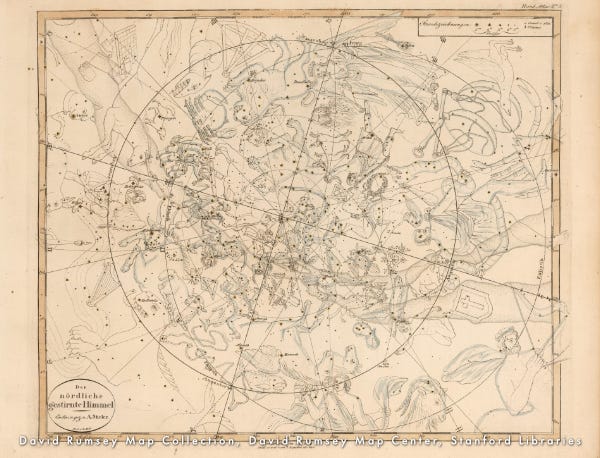
18) Toy astronaut space helmet, Ideal, ca 1960s
What better vessel to contain your Moonlight Dreams than an astronaut space helmet from Ideal?

19) Space Age, Educational Posters #117, 1959
If you had this poster on your bedroom wall, you were one lucky kid. It contains a collection of nineteen separate illustrations of mostly predicted spacecraft, rockets, and space stations. The artist is thought to be Richard Amundsen who worked for Dow Company in the late 1950s.56
As was the case with many publications of the time, artists borrowed heavily from preexisting works. This poster is no exception. About a half a dozen of the illustrations were evidently referenced from the illustrations by Chesley Bonestell, Fred Freeman, and Rolf Klep in Collier’s space articles that were published in the early 1950s by Wernher von Braun and others. Other illustrations on the poster no doubt had their origins in earlier publications and model kit box art, though which came first is perhaps debatable in some cases. The one real vehicle shown among the imaginary ones, as far as I know, is the North American X-15 rocket plane which first flew in 1959, the year this poster was published. Though, one could make a case that the three stage rocket in the upper left appears very similar to a Vanguard rocket, with the exception of the wing-like shapes on the third stage.
Readers’ note: There are excellent write-ups about this poster at Winchell Chung’s Atomic Rockets and John Sisson’s Dreams of Space blog, for those interested.
20) Apollo Manned Lunar Landing GOSS (Ground Operational Support Systems) - Mission Profile, NASA Office Manned Space Flight, 19697
Your bedroom could pass for Mission Control if you had this giant poster on your wall! I consider this to be the ultimate guide to the Apollo mission profile and events. Sure, there were cool illustrations on other posters and in books of isolated key moments on the way to the Moon and back. But, this poster laid it all out for you in a format that allowed you to follow along the flight path.
Just as in Moonlight Dreams, this poster hung over by bed when I was a kid. I have vivid memories of standing on the bed and tracing out, with my finger, each mission milestone along the path. Even now, writing about it, I can hear the voices of Mission Control and the astronauts as they traversed the space between the Earth and Moon.
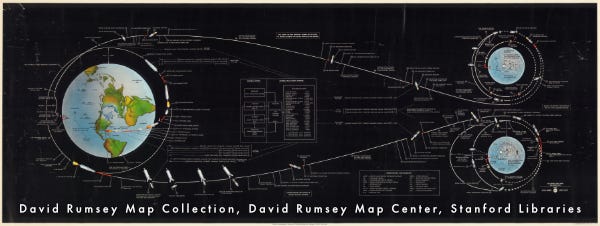
21) Trip to the Moon, Esso/Hammond Inc., 19698
Another in the Esso filling station giveaways, and yet another example of the illustrated Apollo mission events genre. This poster breaks down the Apollo lunar mission into nine easy steps from launch to splashdown.
The creators of this poster chose to use an actual photograph of a Saturn V launch to kick off the series of otherwise illustrated steps. For me, the artists’ concepts are more impactful than photographs. Illustrators are able to infuse drama into their depictions in ways photographs generally do not. They can put the viewer in positions to see what no one else could, in actuality. And, they could simulate time lapses to illustrate a progression of complex steps by essentially creating double and triple exposures. Added to all these abilities afforded the artists, they could also capture attention with exaggerated and unrealistic colors to further enhance the viewing experience.

22) Solar system poster
Tucked away in the back corner of the bedroom in Moonlight Dreams is one of my own artistic creations. I made the digital rendering of the Solar System for the Museum of Flight’s space exhibit in Seattle in 2007. While my rendering obviously would not have been in anyone’s room in the Apollo era, no doubt other illustrations of our Sun and planets did adorn many bedroom walls at the time.
23) Paper Mache Earth and Moon with glow-in-the-dark stars
Did you ever make your own Earth and Moon with Paper Mache? A newspaper, paste, water, a balloon, and some tempera paints were all the cosmic elements you needed to create your own solar system. Hang them up with string, then add some glow-in-the-dark stars and dream of flying among them.
Bonus: Cat
What space room would be complete without a space cat? Here’s a little peek behind the scenes at how I model the objects in a scene like Moonlight Dreams.
My space-inspired art portfolio can be found at pixel-planet-pictures.com. You can also follow me on Instagram (pixelplanetpics).
Do you know fellow Space Geeks who might enjoy Creating Space? Invite them into this space, too!
Did you miss a post? Catch up here.
If you enjoyed this article please hit the ‘Like’ button and feel free to comment.
A special offer for readers of Creating Space ...
If you’ve been reading down to the bottom of each post, you know that I have a website called Pixel Planet Pictures where I display and sell my space-inspired artwork. I invite you to visit my site.
If you are considering adding some of my artwork to your collection, I have good news for you.
As a special thank-you for reading Creating Space, I am offering a discount on my artwork.
Simply use code CREATINGSPACE15% for 15% off your entire order from the Pixel Planet Pictures shop.
All images and text copyright © Dave Ginsberg, unless otherwise noted. All rights reserved.
David Rumsey Map Collection, David Rumsey Map Center, Stanford Libraries
Rumsey
National Geospatial-Intelligence Agency, NGA in History - Defining Moments, Aeronautical Chart and Information Center
Rumsey
Atomic Rockets, Poster: Space Age, Winchell Chung
Dreams of Space, Space Age (1959), John Sisson
Rumsey
Rumsey








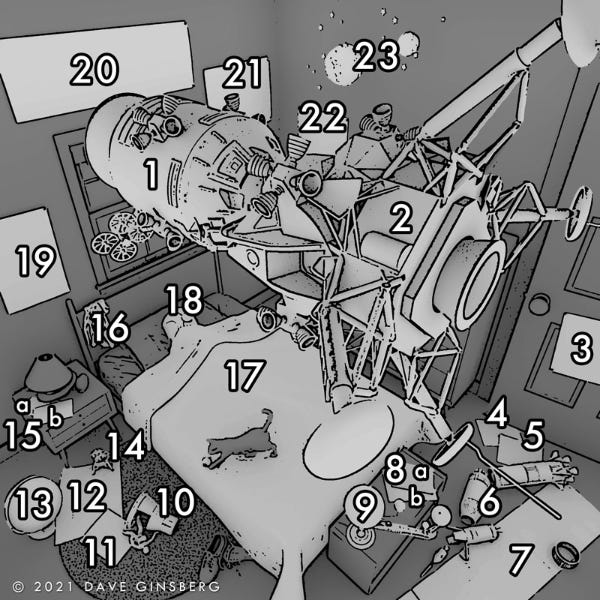
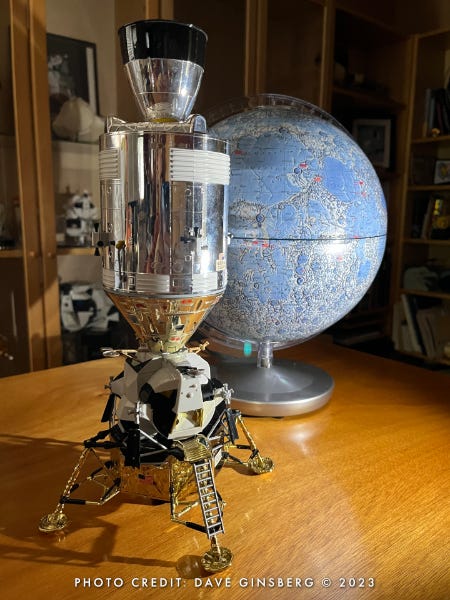



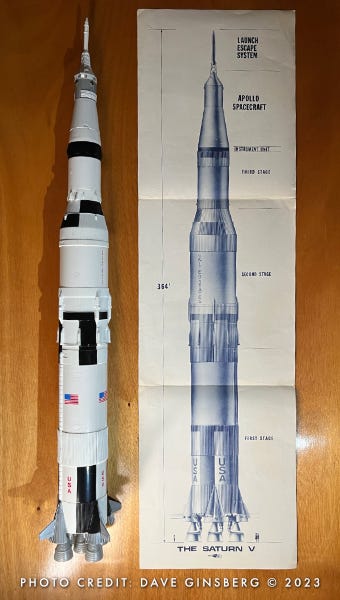







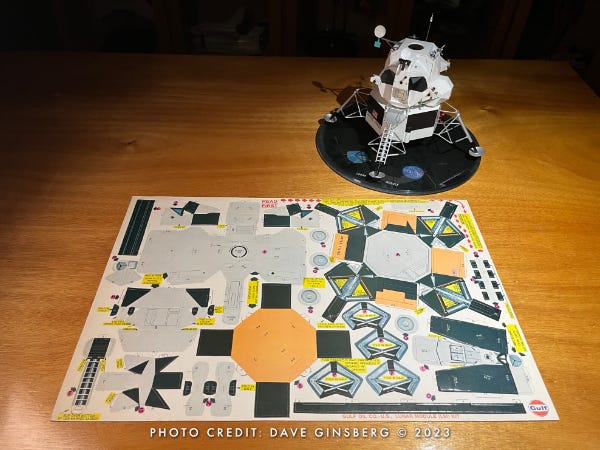


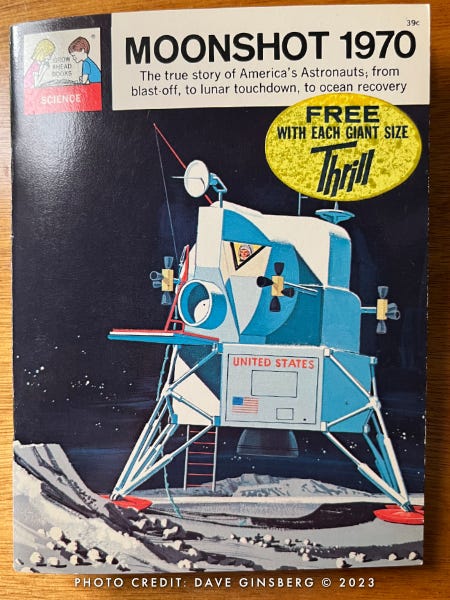











Nice!
What an amazing deep dive!! I really enjoyed the breakdown of all the objects rendered. I missed the Apollo era by a few years, but I had similar things in my room growing up (the National Geographic map of the Moon among them.) 😁